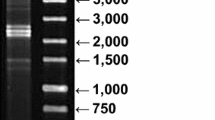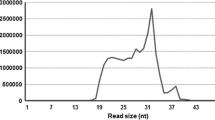Abstract
Fungal viruses (mycoviruses) are frequently found in several plant pathogenic fungi. This study was aimed at examining mycoviral sequences in the fungus Podosphaera prunicola, the causal agent of powdery mildew disease in sweet cherry. Double-stranded RNA (dsRNA) preparations of fungal conidia and mycelium scraped from infected cherry leaves were subjected to next-generation sequencing (NGS). The quality filtered NGS reads were assembled de novo into contigs and subjected to BLASTn and BLASTx analyses against sequences available in public databases. The results showed the presence of mycovirus-related RNA sequences. Four of these sequences, ranging in size between 1915 and 2334 nucleotides (nt), contained a single open reading frame (ORF) encoding a protein with similarity to the RNA-dependent RNA polymerase of viruses in the family Partitiviridae. Three additional sequences, ranging in size between 1736 and 2104 nt, contained a single ORF encoding a putative protein similar to the capsid protein of viruses in the family Partitiviridae. Another sequence of 11,449 nt containing four putative ORFs showed similarity to the genome of Macrophomina phaseolina tobamo-like virus, an unclassified mycovirus in the family Virgaviridae. These analyses lead to the conclusion that the eight sequences represent genome segments of five novel mycoviruses.




Similar content being viewed by others
References
Adams MJ, Antoniw JF, Kreuze J (2009) Virgaviridae: a new family of rod-shaped plant viruses. Arch Virol 154:1967–1972
Ahn IP, Lee YH (2001) A viral double-stranded RNA up regulates the fungal virulence of Nectria radicicola. Mol Plant-Microbe Interact 14:496–507
Al Rwahnih M, Daubert S, Golino D, Rowhani A (2009) Deep sequence analysis of RNAs from grapevine showing Syrah decline symptoms reveals a multiple virus infection that includes a novel virus. Virology 387:395–401
Al Rwahnih M, Daubert S, Urbez-Torres JR, Cordero F, Rowhani A (2011) Deep sequencing evidence from single grapevine plants reveals a virome dominated by mycoviruses. Arch Virol 156:397–403
Anagnostakis SL (1982) Biological control of chestnut blight. Science 215(4532):466–471
Arous S, Marais A, Faure C, Svanella-Dumas L, Candresse T (2013) Partial sequence of a new Partitivirus-infecting Podosphaera tridactyla, the Prunus powdery mildew agent. Virus Genes 46:199–200
Azzam OI, Gonsalves D (1991) Detection of dsRNA from cleistothecia and conidia of the grape powdery mildew pathogen Uncinula necator. Plant Dis 75:964–967
Braun U, Cook RTA (2012) Taxonomic manual of the Erysiphales (Powdery Mildews). CBS Biodiversity Series 11. CBS-KNAW Fungal Biodiversity Centre. Utrecht, The Netherlands
Chiba S, Salaipeth L, Lin YH, Sasaki A, Kanematsu S, Suzuki N (2009) A novel bipartite double-stranded RNA mycovirus from the white root rot fungus Rosellinia nectary: molecular and biological characterization, taxonomic considerations, and potential for biological control. J Virol 83:12801–12812
Chu M, Jean J, Yea SJ, Kim YH, Lee YW, Kim KH (2002) Double-strand RNA mycoviruses from Fusarium graminearum. Appl Environ Microbiol 68(5):2529–2534
Donaire L, Wang Y, Gonzalez-Ibeas D, Mayer KF, Aranda MA, Llave C (2009) Deep-sequencing of plant viral small RNAs reveals effective and widespread targeting of viral genomes. Virology 392:203–214
Edgar RC (2004) MUSCLE: multiple sequence alignment with high accuracy and high throughput. Nucleic Acids Res 32:1792–1797
Ghabrial SA, Suzuki N (2009) Viruses of plant pathogenic fungi. Annu Rev Phytopathol 47:353–384
Ghabrial SA, Castón JR, Jiang D, Nibert ML, Suzuki N (2015) 50-plus years of fungal viruses. Virology 479-480:356–368
Grove GG (1998) Meteorological factors affecting airborne conidia concentrations and the latent period of powdery mildew of sweet cherry. Plant Dis 82:741–746
Grove GG, Boal RJ (1991) Overwinter survival of Podosphaera clandestine in Eastern Washington. Phytopathology 81:385–391
Grove GG, Boal RJ, Bennett LH (2000) Managing powdery mildew of cherry in Washington orchards and nurseries with spray oils. Online Plant Health Progress. https://doi.org/10.1094/PHP-2000-0728-01
Hadidi A, Flores R, Candresse T, Barba M (2016) Next-generation sequencing and genome editing in plant virology. Front Microbiol 7:1325
Hong Y, Dover SL, Cole TE, Brasier CM, Buck KW (1999) Multiple mitochondrial viruses in an isolate of the Dutch elm disease fungus Ophiostoma novo-ulmi. Virology 258:118–127
Jian J, Lakshman DK, Tavantzis SM (1997) Association of distinct double stranded RNAs with enhanced or diminished virulence in Rhizoctonia solani infecting potato. Mol Plant-Microbe Interact 10:1002–1009
Kondo H, Hisano S, Chiba S, Maruyama K, Andika IB, Toyoda K, Fujimori F, Suzuki N (2016) Sequence and phylogenetic analyses of novel totivirus-like double-stranded RNAs from field-collected powdery mildew fungi. Virus Res 213:353–364
Li L, Tiam Q, Du Z, Duns GJ, Chen J (2009) A novel double stranded RNA virus detected in Primula malacoidesis a plant-isolated partitivirus closely related to partivirus infecting fungal species. Arch Virol 154:565–572
Lim WS, Jeong JH, Jeong RD, Yoo YB, Yie SW, Kim KH (2005) Complete nucleotide sequence and genome organization of a dsRNA partitivirus infecting Pleurotus ostreatus. Virus Res 108:111–119
Marais A, Faure C, Couture C, Bergey B, Gentit P, Candresse T (2014) Characterization by deep sequencing of divergent Plum bark necrosis stem pitting virus isolates and development of a broad-spectrum PBNSPaV detection assay. Phytopathology 104:660–666
Marais A, Faure C, Mustafayev E, Barone M, Alioto D, Candresse T (2015) Characterization by deep sequencing of Prunus virus T, a novel tepovirus infecting Prunus species. Phytopathology 105:135–140
Marzano SL, Domier LL (2016) Novel mycoviruses discovered from metatranscriptomics survey of soybean phyllosphere phytobiomes. Virus Res 213:332–342
Marzano SL, Nelson BD, Ajayi-Oyetunde O, Bradley CA, Hughes TJ, Hartman GL, Eastburn DM, Domier LL (2016) Identification of diverse mycoviruses through metatranscriptomics characterization of the viromes of five major fungal plant pathogens. J Virol 90:6846–6863
Massart S, Olmos A, Jijakli H, Candresse T (2014) Current impact and future directions of high throughput sequencing in plant virus diagnostics. Virus Res 188:90–96
Nibert ML, Ghabrial SA, Maiss E, Lesker T, Vainio EJ, Jiang D, Suzuki N (2014) Taxonomic reorganization of family Partitiviridae and other recent progress in partitivirus research. Virus Res 188:128–141
Nuss DL (2005) Hypovirulence: Mycoviruses at the fungal-plant interface. Nat Rev Microbiol 3:632–642
Pearson MN, Beever RE, Boine B, Arthur K (2009) Mycoviruses of filamentous fungi and their relevance to plant pathology. Mol Plant Pathol 10:115–128
Potgieter C. A., Castillo A., Castro M., Cottet L., Morales A., (2013) A wild-type Botrytis cinerea strain co-infected by double-stranded RNA mycoviruses presents hypovirulence-associated traits. Virol J 10:220
Radford AD, Chapman D, Dixon L, Chantrey J, Darby AC, Hall N (2012) Application of next-generation sequencing technologies in virology. J Gen Virol 93:1853–1868
Schoebel CN, Zoller S, Rigling D (2014) Detection and genetic characterisation of a novel mycovirus in Hymenoscyphus fraxineus, the causal agent of ash dieback. Infect Genet Evol 28:78–86
Strauss EE, Lakshman DK, Tavantzis SM (2000) Molecular characterization of the genome of a partitivirus from the basidiomycete Rhizoctonia solani. J Gen Virol 81:549–555
Sun LY, Nuss DL, Suzuki N (2006) Synergism between a mycoreovirus and a hypovirus mediated by the papain-like protease p29 of the prototypic hypovirus CHV1-EP713. J Gen Virol 87:3703–3714
Thompson JD, Higgins DG, Gibson TJ (1994) CLUSTER W: improving the sensitivity of progressive multiple sequence alignment through sequence weighting, positions-specific gap penalties and weight matrix choice. Nucleic Acids Res 22:4673–4680
Vainio EJ, Jurvansuu J, Streng J, Ki MR, Hantula J, Valkonen JPT (2015) Diagnosis and discovery of fungal viruses using deep sequencing of small RNAs. J Gen Virol 96:714–725
Villamor DEV, Mekuria TA, Pillai SS, Eastwell KC (2016) High throughput sequencing identifies novel viruses in nectarine: insights to the etiology of stem pitting disease. Phytopathology 106:519–527
Wu MD, Zhang L, Li GQ, Jiang DH, Hou MS, Huang HC (2007) Hypovirulence and double-stranded RNA in Botrytis cinerea. Phytopathology 97:1590–1599
Wu MD, Jin F, Zhang J, Yang L, Jiang D, Li G (2012) Characterization of a novel bipartite double-stranded RNA mycovirus conferring hypovirulence in the phytopathogenic fungus Botrytis porri. J Virol 86:6605–6619
Xiao X, Cheng J, Tang J, Fu Y, Jiang D, Baker TS, Ghabrial SA, Xie J (2014) A novel partitivirus that confers hypovirulence on plant pathogenic fungi. J Virol 88:10120–10133
Xie J, Jiang D (2014) New insights into mycoviruses and exploration for the biological control of crop fungal diseases. Annu Rev Phytopathol 52:45–68
Yarwood CE, Hecht-Poinar E (1973) Virus from rusts and mildews. Phytopathology 63:111–112
Yu X, Li B, Fu Y, Jiang D, Ghabrial SA, Li G, Peng Y, Xie J, Cheng J, Huang J, Yi X (2010) A geminivirus-related DNA mycovirus that confers hypovirulence to a plant pathogenic fungus. Proc Natl Acad Sci U S A 107:8387–8392
Yu X, Li B, Fu Y, Xie J, Cheng J, Ghabrial SA, Li G, Yi X, Jiang D (2013) Extracellular transmission of a DNA mycovirus and its use as a natural fungicide. Proc Natl Acad Sci U S A 110:1452–1457
Zabalgogeazcoa I, Benito EP, Ciudad AG, Criado BG, Eslava AP (1998) Double-stranded RNA and virus-like particles in the grass endophyte Epichloe festucae. Mycol Res 102:914–918
Zheng L, Zhang M, Chen Q, Zhu M, Zhou E (2014) A novel mycovirus closely related to viruses in the genus Alphapartitivirus confers hypovirulence in the phytopathogenic fungus Rhizoctonia solani. Virology 456-457:220–226
Acknowledgements
We would like to acknowledge Washington State University, Agricultural Research Center for the support of this study.
Author information
Authors and Affiliations
Corresponding author
Electronic supplementary material
ESM 1
(DOCX 589 kb)
Rights and permissions
About this article
Cite this article
Pandey, B., Naidu, R.A. & Grove, G.G. Next generation sequencing analysis of double-stranded RNAs from sweet cherry powdery mildew fungus Podosphaera prunicola. J Plant Pathol 100, 435–446 (2018). https://doi.org/10.1007/s42161-018-0092-0
Published:
Issue Date:
DOI: https://doi.org/10.1007/s42161-018-0092-0




